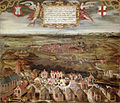Siege of Alkmaar
| Siege of Alkmaar | |||||||
|---|---|---|---|---|---|---|---|
| Part of the Eighty Years' War | |||||||
 The siege of Alkmaar by Frans Hogenberg | |||||||
| |||||||
| Belligerents | |||||||
|
|  Spain Spain | ||||||
| Commanders and leaders | |||||||
 Jacob Cabeliau Jacob Cabeliau |  Fadrique Álvarez de Toledo Fadrique Álvarez de Toledo | ||||||
| Strength | |||||||
| 2000 (Geuzen and Civilians)[2] | 16,000 troops (estimated)[3] | ||||||
| Casualties and losses | |||||||
| 24+ geuzen, 13 civilians | over 500 | ||||||
- v
- t
- e
Western Europe
- Beeldenstorm
- Valenciennes
- Wattrelos
- Lannoy
- Oosterweel
- Dahlen
- Heiligerlee
- Jemmingen
- Jodoigne
- Le Quesnoy
Western Europe
- Brielle
- Mons
- 1st Mechelen
- Goes
- Naarden
- Middelburg
- Haarlem
- IJsselmeer
- Alkmaar
- 1st Geertruidenberg
- Leiden
- Delft
- Valkenburg
- Mookerheyde
- Oudewater
- Schoonhoven
- Zierikzee
- European waters
- Flushing
- Borsele
- Haarlemmermeer
- Zuiderzee
- Reimerswaal
- Lillo
Western Europe
- 1st Antwerp
- Gembloux
- Rijmenam
- 1st Deventer
- Borgerhout
Western Europe
- 1st Maastricht
- 2nd Mechelen
- Diest
- 1st Steenwijk
- Kollum
- 1st Breda
- Noordhorn
- Niezijl
- Lochem
- 1st Lier
- 2nd Antwerp
- Eindhoven
- Steenbergen
- Ghent
- Aalst
- 3rd Antwerp
- Arnhem
- Empel
- Boksum
- 1st Grave
- 1st Venlo
- Axel
- Neuss
- 1st Rheinberg
- 1st Zutphen
- 1st Sluis
- European waters
- Ten Years, 1588–1598
Western Europe
- 1st Bergen op Zoom
- 2nd Geertruidenberg
- 2nd Breda
- 2nd Zutphen
- 2nd Deventer
- Delfzijl
- Knodsenburg
- 1st Hulst
- Nijmegen
- Rouen
- Caudebec
- 2nd Steenwijk
- 1st Coevorden
- 1st Luxemburg
- 3rd Geertruidenberg
- 2nd Coevorden
- Groningen
- 2nd Luxemburg
- Huy
- 1st Groenlo
- Lippe
- 2nd Lier
- Calais
- 2nd Hulst
- Turnhout
- 2nd Rheinberg
- 1st Meurs
- 2nd Groenlo
- Bredevoort
- Enschede
- Ootmarsum
- 1st Oldenzaal
- 1st Lingen
- European waters
Western Europe
- 1st Schenckenschans
- Zaltbommel
- Rees
- San Andreas
- Lekkerbeetje
- Nieuwpoort
- 3rd Rheinberg
- Ostend
- 1st 's-Hertogenbosch
- 2nd Grave
- Hoogstraaten
- 3rd Sluis
- 2nd Lingen
- 3rd Groenlo
- European waters
- Dover Strait
- 2nd Sluis
- 1st Cape St. Vincent
- 1st Gibraltar
- Twelve Years' Truce, 1609–1621
Western Europe
- Aachen
East Indies
Western Europe
- Jülich
- 2nd Bergen op Zoom
- Fleurus
- 3rd Breda
- 2nd Oldenzaal
- 4th Groenlo
- 2nd 's-Hertogenbosch
- Meuse (2nd Maastricht)
- Leuven
- 2nd Schenkenschans
- 3rd Schenkenschans
- 4th Breda
- 2nd Venlo
- Roermond
- Kallo
- 3rd Hulst
- 4th Hulst
European waters
- 2nd Gibraltar
- 2nd Cádiz
- Slaak
- Lizard Point
- Dunkirk
- 2nd English Channel
- The Downs
- 2nd Cape St. Vincent
Americas
- 1st Salvador
- Puerto Rico
- Bay of Matanzas
- Abrolhos
- Trujillo · Campeche
- 1st Saint Martin
- 2nd Salvador
- Itamaracá
- Southern Chile
- 2nd Saint Martin
East Indies
The siege of Alkmaar (1573) was a turning point in the Eighty Years' War. The burghers of the Dutch city of Alkmaar held off the Spanish (who had set up their camp in Oudorp) between 21 August and 8 October 1573, with boiling tar and burning branches from their renewed city walls. On 23 September William the Silent followed up on a request by Cabeliau dating from the beginning of the siege and ordered the dikes surrounding Alkmaar to be breached, thereby flooding the polders in which the Spanish troops were camped, like the Achtermeer polder. This forced the Spanish commander, Don Fadrique, the son of the hated Alva himself, to retreat and the last Spanish soldiers left on 8 October 1573.[4]
The end of the siege is considered a turning point in the Eighty Years' War as Alkmaar was the first city to overcome a siege by the Spanish army.
The garrison included a detachment of Scots soldiers who had previously tried to defend Haarlem.[5]
A first-hand account of the siege exists in the diary of Nanning van Foreest [nl], a local city councillor. Several archaeological examinations have uncovered remains of the battle.[1]
-
 A painting showing unfinished fortifications
A painting showing unfinished fortifications
References
- Citations
- Bibliography
- Nolan, Cathal J. (2006). The Age of Wars of Religion, 1000–1650: An Encyclopedia of Global Warfare and Civilization. Greenwood Publishing Group. ISBN 978-0313330452.
- Knüsel, Christopher; Smith, Martin (2013). The Routledge Handbook of the Bioarchaeology of Human Conflict. Routledge. ISBN 978-1134677979.
- Beets, Pieter (1873). Strijd en zegepraal, of De belegering en het ontzet van Alkmaar, in het jaar 1573. Herm. Coster & Zoon.
52°38′N 4°45′E / 52.63°N 4.75°E / 52.63; 4.75










